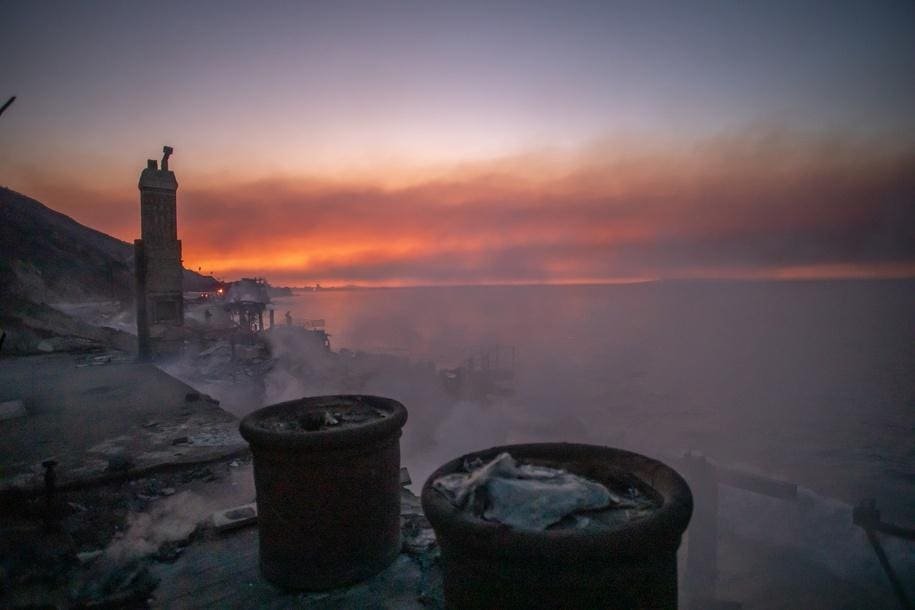The Los Angeles area wildfires are producing a large amount of smoke as can be seen on January 10, … [+]
Getty Images
As wildfires continue to rage in the Los Angeles area, it should be obvious that the flames themselves are major threats, leaving devastation in their trails. So is the intense heat generated. But remember, where there’s fire, there’s smoke, which may be a reversal of the standard proverb but is highly relevant here. The wildfires are creating large amounts of smoke that are themselves major threats. And these huge billows of wildfire smoke will remain huge problems for a while and could end up traveling huge distances from the flames.
Wildfire Smoke Contains Particulate Matter
That’s because wildfire smoke can contain all sorts of harmful substances. Any type of smoke contains particulate matter, which is a more refined way of saying bits and pieces of substances floating in the air. This particulate matter can range from visible debris floating in the air to smaller particles.
Particulate matter is a concern because the smaller the particles, the more likely they are to enter your respiratory tract and potentially reach your lungs. Of particular concern are the “fine inhalable particles” or PM2.5, which are particles that are 2.5 micrometers or smaller. These tiny particles can cause irritation and damage to the smallest airways of your lungs and can also affect your cardiovascular system. Inhaling such particles can lead to breathing issues, asthma attacks, lung problems, and increase the risk of heart attacks and stroke, especially in individuals with other risk factors.
Another issue with these fine inhalable particles is that they can be too small to see. Therefore, the air may appear clear but actually be filled with PM2.5 particles. Don’t rely solely on your eyes to determine air quality.
Particulate matter can also irritate the eyes, causing burning and tearing if the air is polluted with particulate matter.
Wildfire Smoke Can Contain Toxic Gases
Burnt material can continue to emit toxic fumes and particulate matter long after the flames have … [+]
Anadolu via Getty Images
Wildfire smoke can also contain various toxic gases resulting from the burning of organic material and other substances. Even after the flames have subsided, charred debris can emit toxic fumes and particulate matter into the air.
The health effects of these toxic fumes depend on the specific chemicals present, ranging from irritation to potential cancer.
Stay Indoors With Wildfire Smoke Outside
If you are in the Los Angeles area, it’s best to stay indoors as much as possible and limit outdoor exposure. Keep windows and doors closed and seal any openings that may let smoke inside. Consider using wet cloths to block openings.
Stay informed about wildfire locations and smoke movement through news or tracking websites. Pay attention to your surroundings.
Air Purifiers With HEPA Filters Can Protect Against Wildfire Smoke
Use air purifiers with HEPA filters to keep indoor air clean. These filters can remove particles from the air, including fine particulate matter. Pay attention to the MERV rating of the filter and replace it regularly.
Avoid Strenuous Physical Activity While Outdoors With Wildfire Smoke
Avoid vigorous outdoor physical activity to reduce inhalation of pollutants. Exercise indoors in clean, filtered air.
N95 Or P100 Face Masks Can Protect You Against Wildfire Smoke
Use N95 or P100 face masks to filter out small particles from the air and protect yourself from wildfire smoke exposure.
In simpler terms, these types of face masks are effective. However, not all face masks will do the job. Bandanas, surgical masks, or novelty masks won’t provide much protection. When choosing a face mask, it’s important to understand the classification system. Look for the letter indicating the type of respirator:
– “N” means “Non-Oil,” indicating the respirator is not resistant to oil.
– “R” means “Resistant to Oil” for up to 8 hours.
– “P” means the respirator is oil-proof.
Unless you’re planning on exposing your mask to oily substances, an “N” respirator should suffice. As long as you have one of these lettered respirators, check the number that follows. This number represents the mask’s efficiency in filtering out particles 0.3 microns or larger. For example, an N95 mask filters out 95% of these particles. Look for masks approved by NIOSH, featuring “NIOSH,” “N95,” or “P100” on the packaging.
These approved masks are made of interlacing propylene fibers that make it difficult for particles to pass through. Wear the mask properly to ensure a tight seal around your mouth and nose. Replace N95 or P100 masks regularly as they lose effectiveness over time. Keep an eye on air quality reports, especially during wildfire season, as smoke can travel long distances and impact air quality. Always monitor air quality indices in your area to stay informed.


